BACT105 Business Accounting: Journal Entries, Trial Balance Report
VerifiedAdded on 2023/04/21
|17
|3246
|336
Report
AI Summary
This business accounting report focuses on the significance of journal entries and trial balance preparation in creating accurate financial statements. It presents journal entries for given adjusting entries and prepares an income statement and balance sheet from the adjusted trial balance. The report explains the purpose of the trial balance in representing balances from the general ledger, ensuring that total debit amounts equal total credit amounts. Adjusting journal entries are used to correct errors before financial statements are finalized. The report details the steps involved, including journal entries for adjustments and closing, worksheet completion, and changes in equity. It further discusses the purposes of creating a trial balance, recording adjusting journal entries, and preparing an adjusted trial balance, highlighting the differences between closing and adjusting entries. This resource, available on Desklib, helps students understand these concepts and provides solved assignments for further learning.
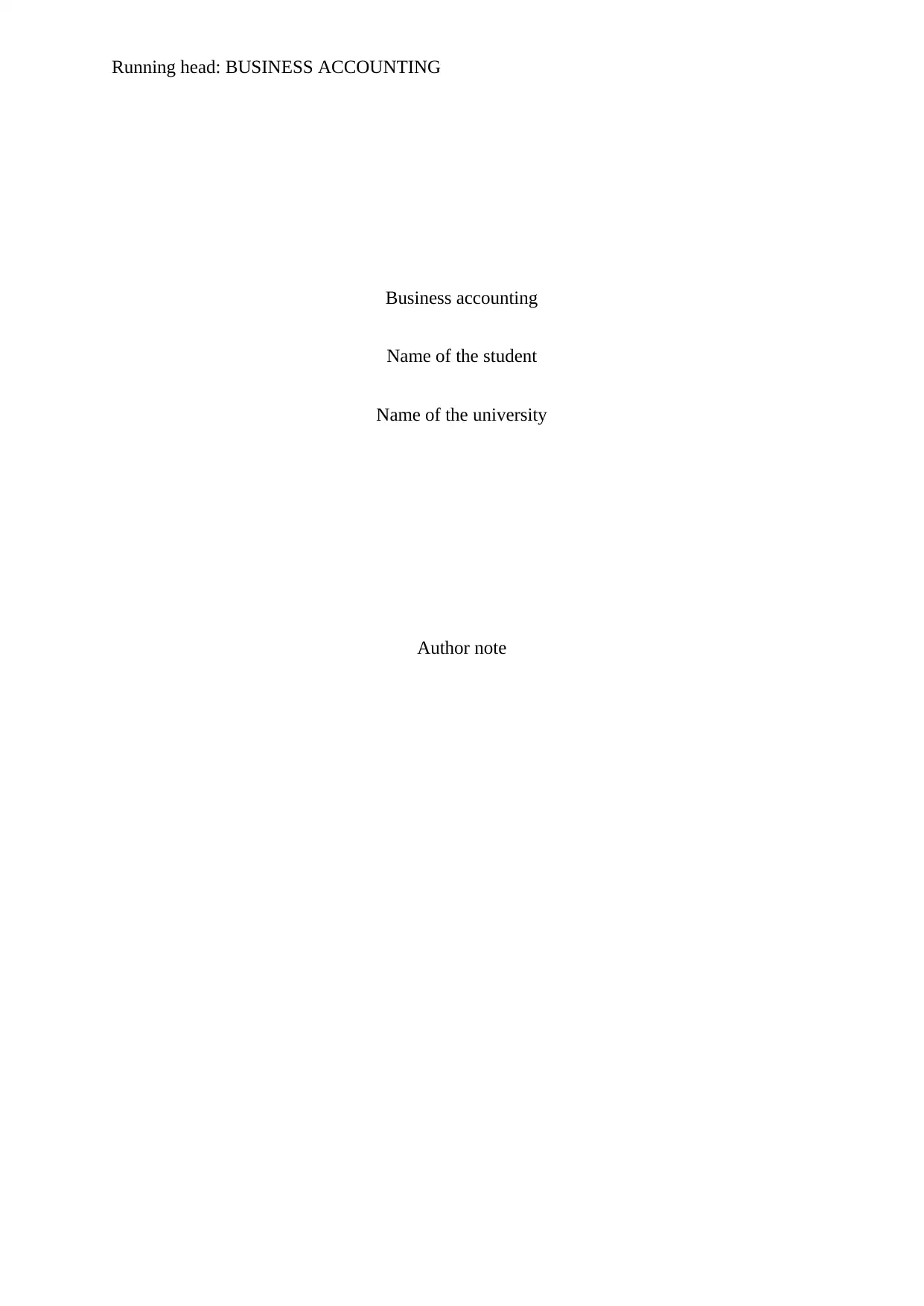
Running head: BUSINESS ACCOUNTING
Business accounting
Name of the student
Name of the university
Author note
Business accounting
Name of the student
Name of the university
Author note
Paraphrase This Document
Need a fresh take? Get an instant paraphrase of this document with our AI Paraphraser
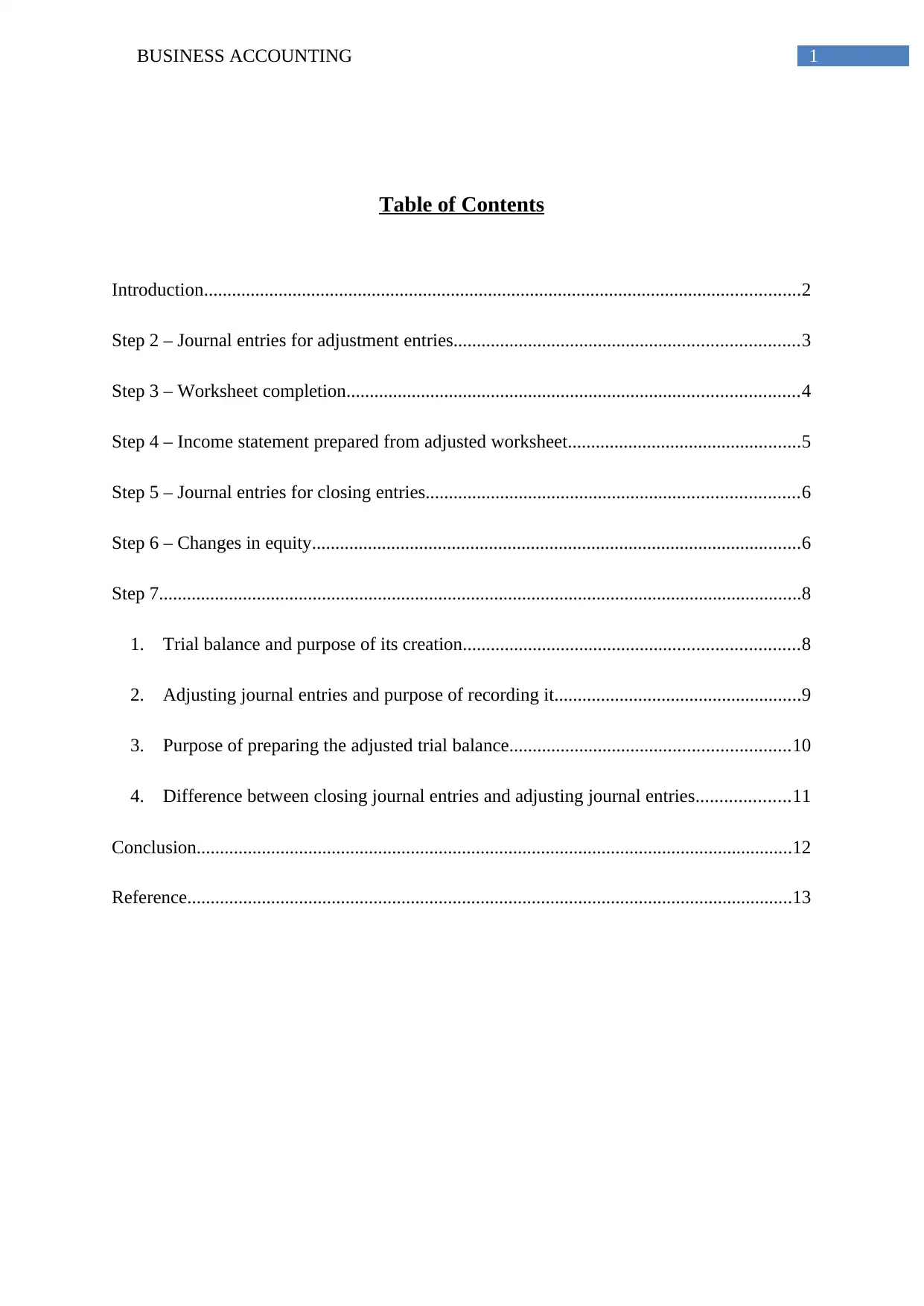
1BUSINESS ACCOUNTING
Table of Contents
Introduction................................................................................................................................2
Step 2 – Journal entries for adjustment entries..........................................................................3
Step 3 – Worksheet completion.................................................................................................4
Step 4 – Income statement prepared from adjusted worksheet..................................................5
Step 5 – Journal entries for closing entries................................................................................6
Step 6 – Changes in equity.........................................................................................................6
Step 7..........................................................................................................................................8
1. Trial balance and purpose of its creation........................................................................8
2. Adjusting journal entries and purpose of recording it.....................................................9
3. Purpose of preparing the adjusted trial balance............................................................10
4. Difference between closing journal entries and adjusting journal entries....................11
Conclusion................................................................................................................................12
Reference..................................................................................................................................13
Table of Contents
Introduction................................................................................................................................2
Step 2 – Journal entries for adjustment entries..........................................................................3
Step 3 – Worksheet completion.................................................................................................4
Step 4 – Income statement prepared from adjusted worksheet..................................................5
Step 5 – Journal entries for closing entries................................................................................6
Step 6 – Changes in equity.........................................................................................................6
Step 7..........................................................................................................................................8
1. Trial balance and purpose of its creation........................................................................8
2. Adjusting journal entries and purpose of recording it.....................................................9
3. Purpose of preparing the adjusted trial balance............................................................10
4. Difference between closing journal entries and adjusting journal entries....................11
Conclusion................................................................................................................................12
Reference..................................................................................................................................13
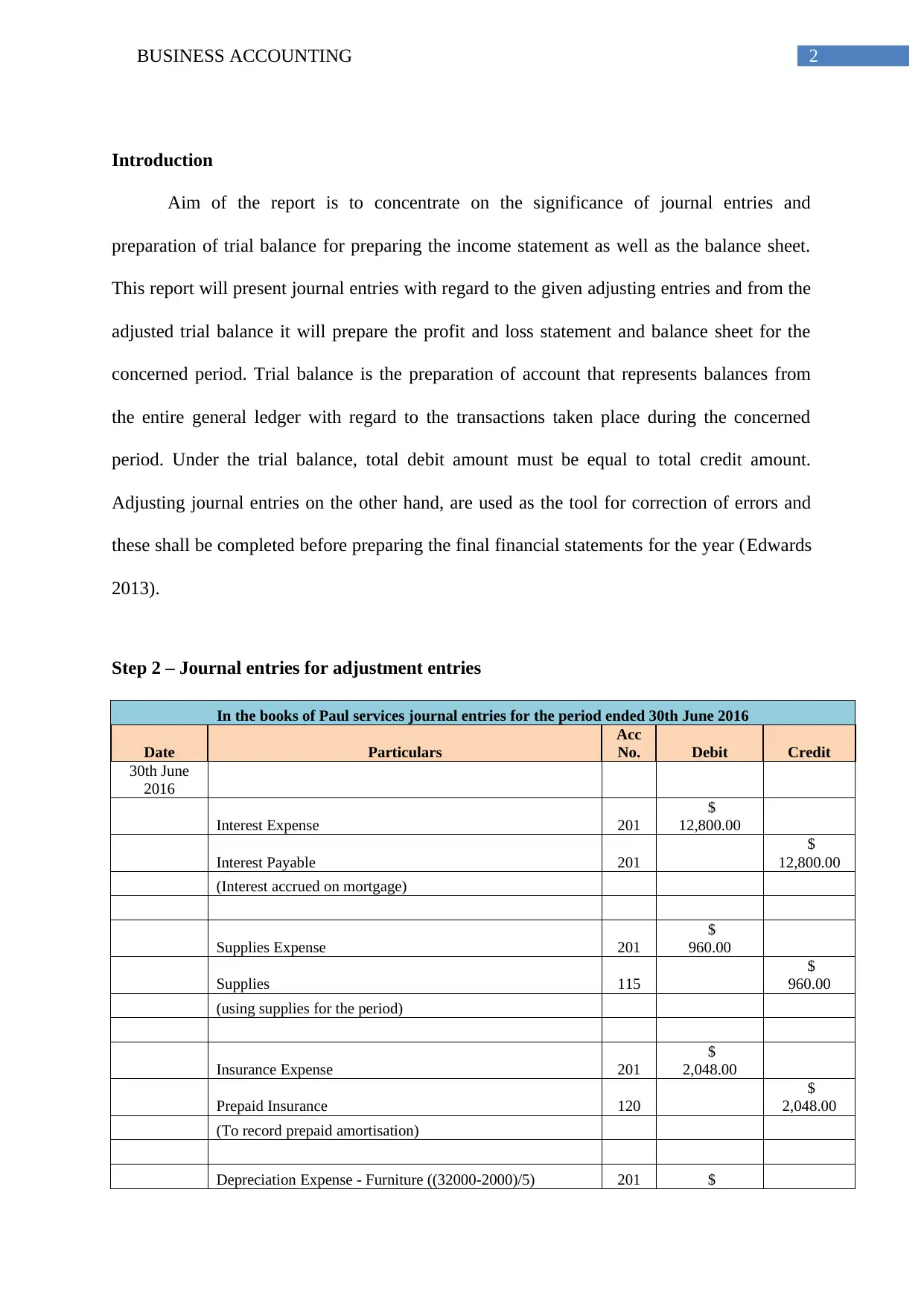
2BUSINESS ACCOUNTING
Introduction
Aim of the report is to concentrate on the significance of journal entries and
preparation of trial balance for preparing the income statement as well as the balance sheet.
This report will present journal entries with regard to the given adjusting entries and from the
adjusted trial balance it will prepare the profit and loss statement and balance sheet for the
concerned period. Trial balance is the preparation of account that represents balances from
the entire general ledger with regard to the transactions taken place during the concerned
period. Under the trial balance, total debit amount must be equal to total credit amount.
Adjusting journal entries on the other hand, are used as the tool for correction of errors and
these shall be completed before preparing the final financial statements for the year (Edwards
2013).
Step 2 – Journal entries for adjustment entries
In the books of Paul services journal entries for the period ended 30th June 2016
Date Particulars
Acc
No. Debit Credit
30th June
2016
Interest Expense 201
$
12,800.00
Interest Payable 201
$
12,800.00
(Interest accrued on mortgage)
Supplies Expense 201
$
960.00
Supplies 115
$
960.00
(using supplies for the period)
Insurance Expense 201
$
2,048.00
Prepaid Insurance 120
$
2,048.00
(To record prepaid amortisation)
Depreciation Expense - Furniture ((32000-2000)/5) 201 $
Introduction
Aim of the report is to concentrate on the significance of journal entries and
preparation of trial balance for preparing the income statement as well as the balance sheet.
This report will present journal entries with regard to the given adjusting entries and from the
adjusted trial balance it will prepare the profit and loss statement and balance sheet for the
concerned period. Trial balance is the preparation of account that represents balances from
the entire general ledger with regard to the transactions taken place during the concerned
period. Under the trial balance, total debit amount must be equal to total credit amount.
Adjusting journal entries on the other hand, are used as the tool for correction of errors and
these shall be completed before preparing the final financial statements for the year (Edwards
2013).
Step 2 – Journal entries for adjustment entries
In the books of Paul services journal entries for the period ended 30th June 2016
Date Particulars
Acc
No. Debit Credit
30th June
2016
Interest Expense 201
$
12,800.00
Interest Payable 201
$
12,800.00
(Interest accrued on mortgage)
Supplies Expense 201
$
960.00
Supplies 115
$
960.00
(using supplies for the period)
Insurance Expense 201
$
2,048.00
Prepaid Insurance 120
$
2,048.00
(To record prepaid amortisation)
Depreciation Expense - Furniture ((32000-2000)/5) 201 $
⊘ This is a preview!⊘
Do you want full access?
Subscribe today to unlock all pages.

Trusted by 1+ million students worldwide
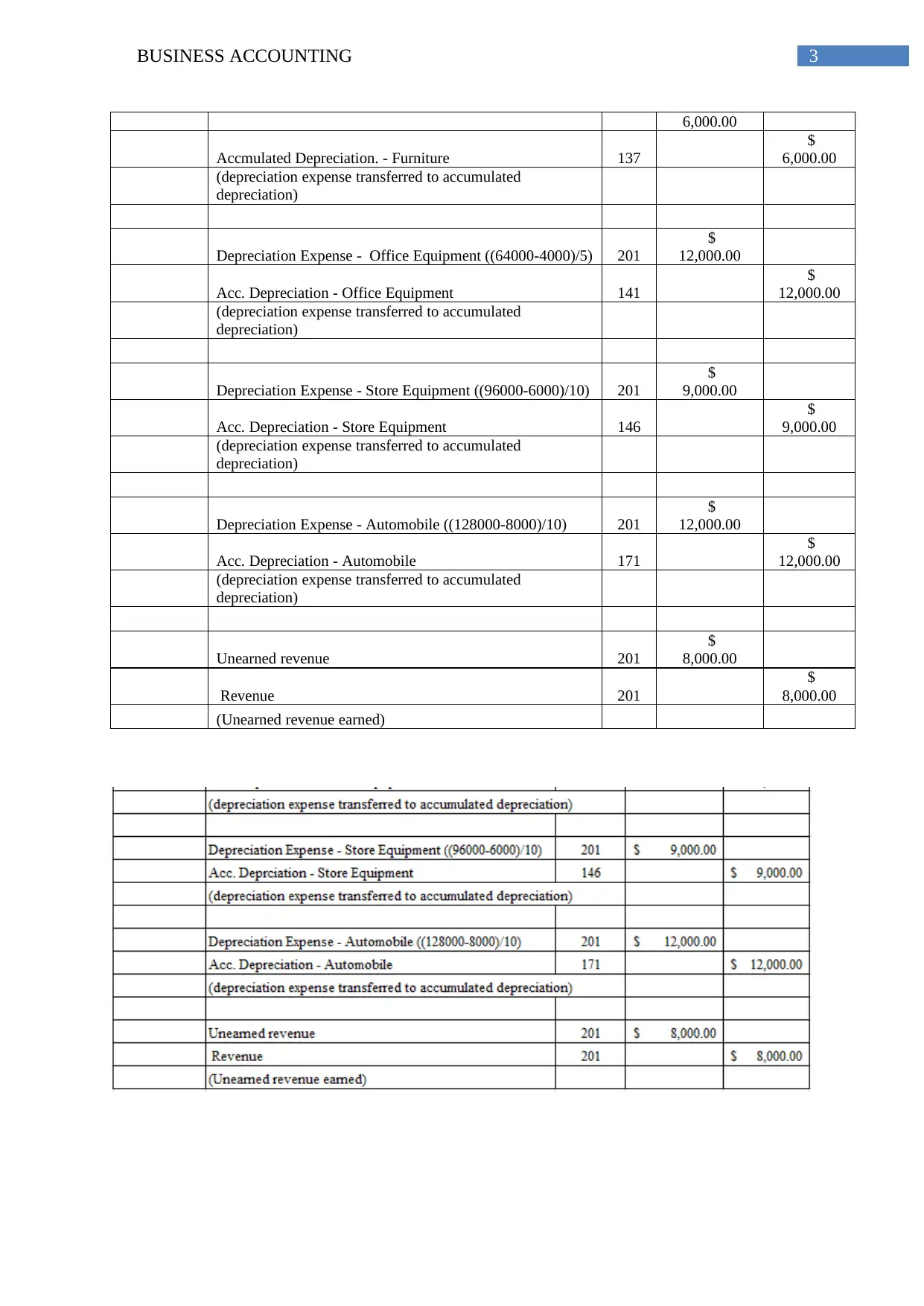
3BUSINESS ACCOUNTING
6,000.00
Accmulated Depreciation. - Furniture 137
$
6,000.00
(depreciation expense transferred to accumulated
depreciation)
Depreciation Expense - Office Equipment ((64000-4000)/5) 201
$
12,000.00
Acc. Depreciation - Office Equipment 141
$
12,000.00
(depreciation expense transferred to accumulated
depreciation)
Depreciation Expense - Store Equipment ((96000-6000)/10) 201
$
9,000.00
Acc. Depreciation - Store Equipment 146
$
9,000.00
(depreciation expense transferred to accumulated
depreciation)
Depreciation Expense - Automobile ((128000-8000)/10) 201
$
12,000.00
Acc. Depreciation - Automobile 171
$
12,000.00
(depreciation expense transferred to accumulated
depreciation)
Unearned revenue 201
$
8,000.00
Revenue 201
$
8,000.00
(Unearned revenue earned)
6,000.00
Accmulated Depreciation. - Furniture 137
$
6,000.00
(depreciation expense transferred to accumulated
depreciation)
Depreciation Expense - Office Equipment ((64000-4000)/5) 201
$
12,000.00
Acc. Depreciation - Office Equipment 141
$
12,000.00
(depreciation expense transferred to accumulated
depreciation)
Depreciation Expense - Store Equipment ((96000-6000)/10) 201
$
9,000.00
Acc. Depreciation - Store Equipment 146
$
9,000.00
(depreciation expense transferred to accumulated
depreciation)
Depreciation Expense - Automobile ((128000-8000)/10) 201
$
12,000.00
Acc. Depreciation - Automobile 171
$
12,000.00
(depreciation expense transferred to accumulated
depreciation)
Unearned revenue 201
$
8,000.00
Revenue 201
$
8,000.00
(Unearned revenue earned)
Paraphrase This Document
Need a fresh take? Get an instant paraphrase of this document with our AI Paraphraser
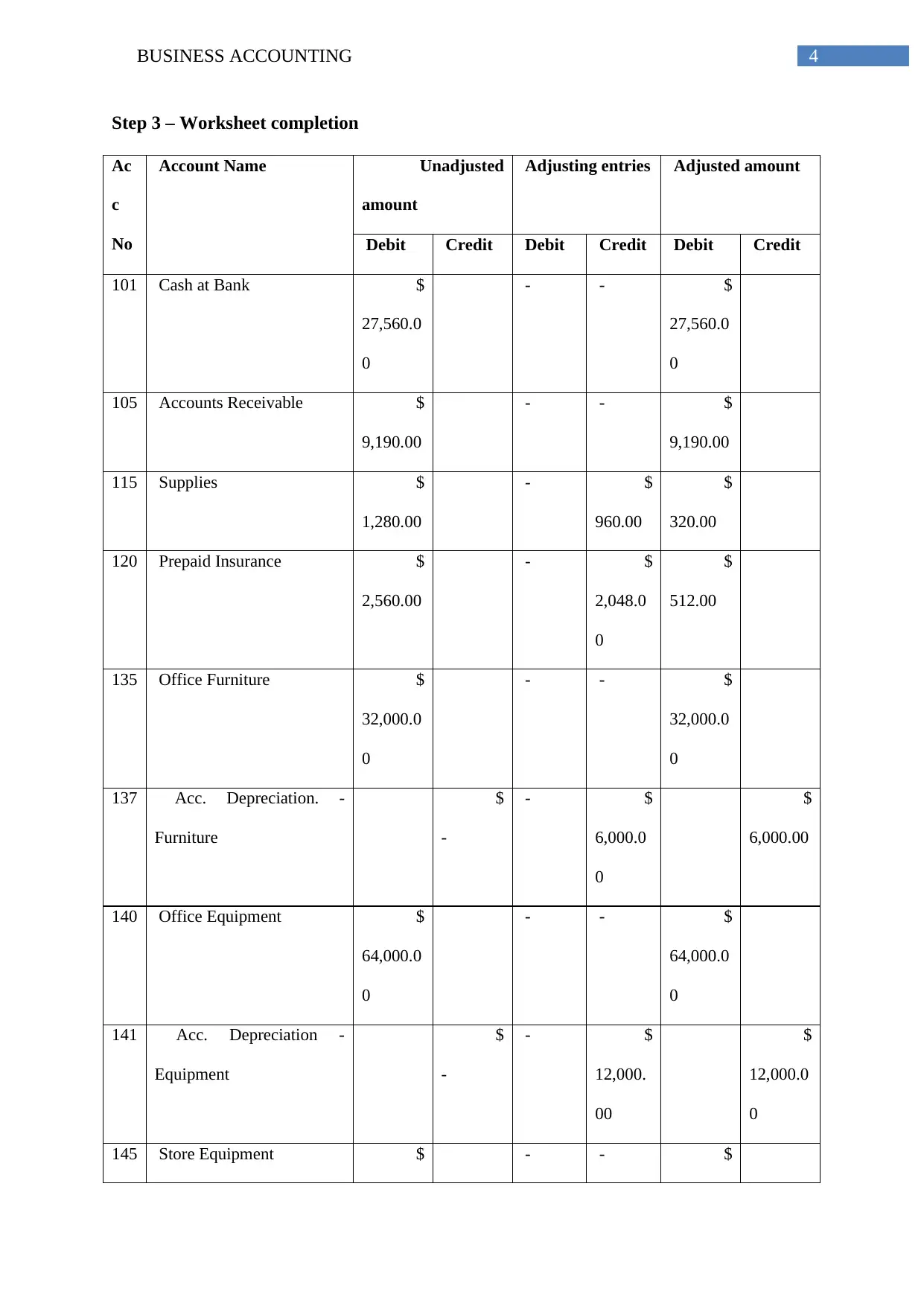
4BUSINESS ACCOUNTING
Step 3 – Worksheet completion
Ac
c
No
Account Name Unadjusted
amount
Adjusting entries Adjusted amount
Debit Credit Debit Credit Debit Credit
101 Cash at Bank $
27,560.0
0
- - $
27,560.0
0
105 Accounts Receivable $
9,190.00
- - $
9,190.00
115 Supplies $
1,280.00
- $
960.00
$
320.00
120 Prepaid Insurance $
2,560.00
- $
2,048.0
0
$
512.00
135 Office Furniture $
32,000.0
0
- - $
32,000.0
0
137 Acc. Depreciation. -
Furniture
$
-
- $
6,000.0
0
$
6,000.00
140 Office Equipment $
64,000.0
0
- - $
64,000.0
0
141 Acc. Depreciation -
Equipment
$
-
- $
12,000.
00
$
12,000.0
0
145 Store Equipment $ - - $
Step 3 – Worksheet completion
Ac
c
No
Account Name Unadjusted
amount
Adjusting entries Adjusted amount
Debit Credit Debit Credit Debit Credit
101 Cash at Bank $
27,560.0
0
- - $
27,560.0
0
105 Accounts Receivable $
9,190.00
- - $
9,190.00
115 Supplies $
1,280.00
- $
960.00
$
320.00
120 Prepaid Insurance $
2,560.00
- $
2,048.0
0
$
512.00
135 Office Furniture $
32,000.0
0
- - $
32,000.0
0
137 Acc. Depreciation. -
Furniture
$
-
- $
6,000.0
0
$
6,000.00
140 Office Equipment $
64,000.0
0
- - $
64,000.0
0
141 Acc. Depreciation -
Equipment
$
-
- $
12,000.
00
$
12,000.0
0
145 Store Equipment $ - - $
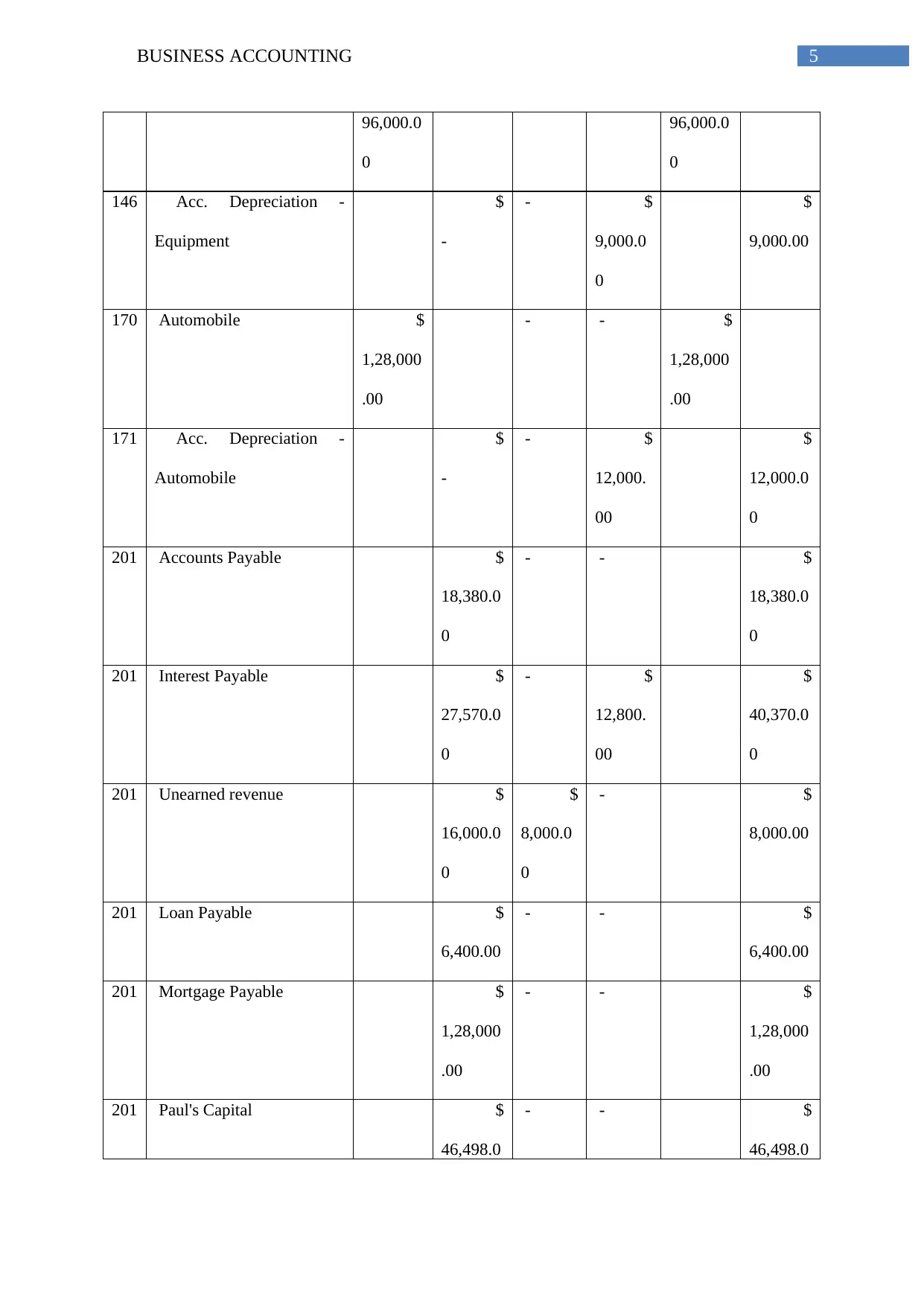
5BUSINESS ACCOUNTING
96,000.0
0
96,000.0
0
146 Acc. Depreciation -
Equipment
$
-
- $
9,000.0
0
$
9,000.00
170 Automobile $
1,28,000
.00
- - $
1,28,000
.00
171 Acc. Depreciation -
Automobile
$
-
- $
12,000.
00
$
12,000.0
0
201 Accounts Payable $
18,380.0
0
- - $
18,380.0
0
201 Interest Payable $
27,570.0
0
- $
12,800.
00
$
40,370.0
0
201 Unearned revenue $
16,000.0
0
$
8,000.0
0
- $
8,000.00
201 Loan Payable $
6,400.00
- - $
6,400.00
201 Mortgage Payable $
1,28,000
.00
- - $
1,28,000
.00
201 Paul's Capital $
46,498.0
- - $
46,498.0
96,000.0
0
96,000.0
0
146 Acc. Depreciation -
Equipment
$
-
- $
9,000.0
0
$
9,000.00
170 Automobile $
1,28,000
.00
- - $
1,28,000
.00
171 Acc. Depreciation -
Automobile
$
-
- $
12,000.
00
$
12,000.0
0
201 Accounts Payable $
18,380.0
0
- - $
18,380.0
0
201 Interest Payable $
27,570.0
0
- $
12,800.
00
$
40,370.0
0
201 Unearned revenue $
16,000.0
0
$
8,000.0
0
- $
8,000.00
201 Loan Payable $
6,400.00
- - $
6,400.00
201 Mortgage Payable $
1,28,000
.00
- - $
1,28,000
.00
201 Paul's Capital $
46,498.0
- - $
46,498.0
⊘ This is a preview!⊘
Do you want full access?
Subscribe today to unlock all pages.

Trusted by 1+ million students worldwide
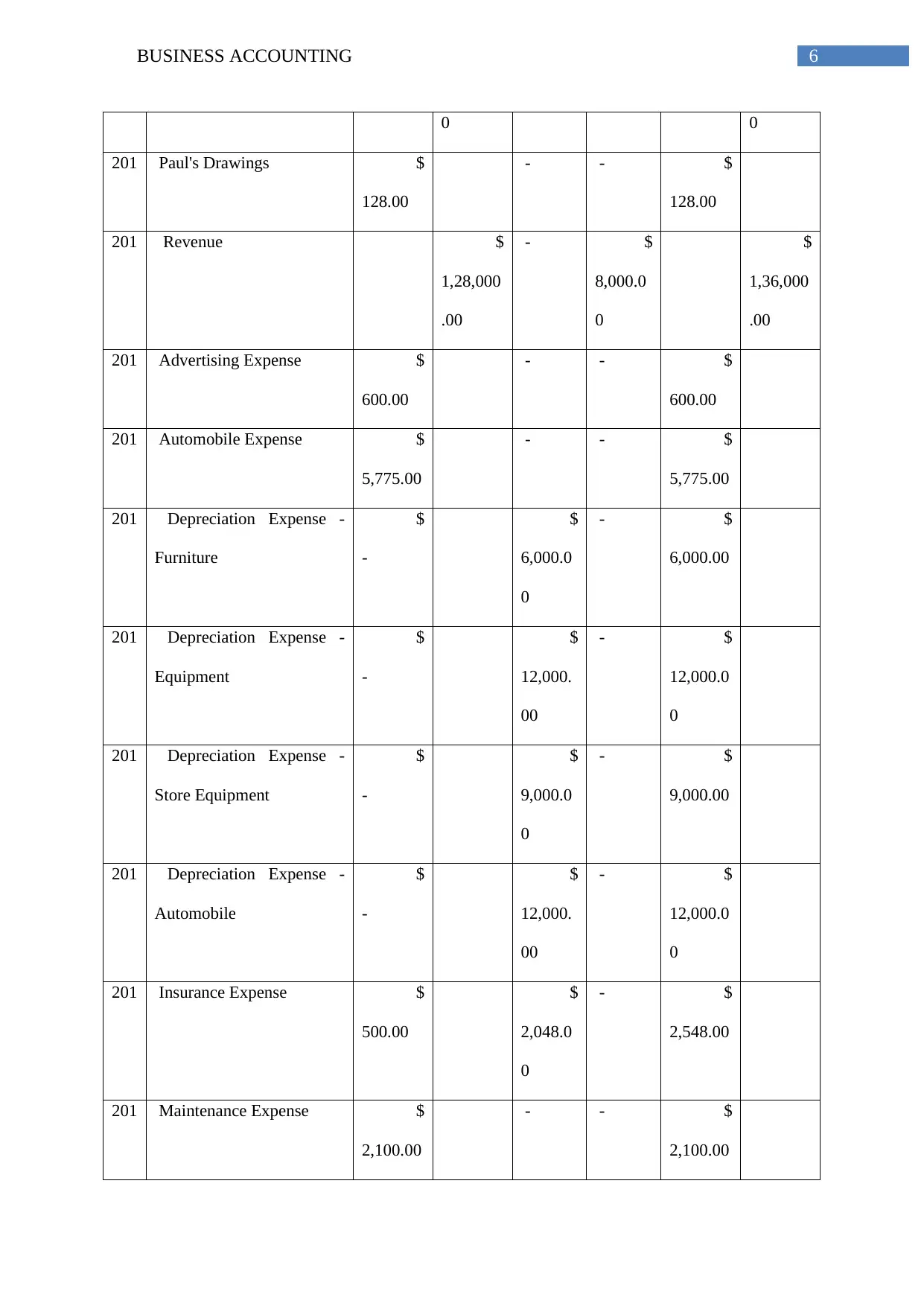
6BUSINESS ACCOUNTING
0 0
201 Paul's Drawings $
128.00
- - $
128.00
201 Revenue $
1,28,000
.00
- $
8,000.0
0
$
1,36,000
.00
201 Advertising Expense $
600.00
- - $
600.00
201 Automobile Expense $
5,775.00
- - $
5,775.00
201 Depreciation Expense -
Furniture
$
-
$
6,000.0
0
- $
6,000.00
201 Depreciation Expense -
Equipment
$
-
$
12,000.
00
- $
12,000.0
0
201 Depreciation Expense -
Store Equipment
$
-
$
9,000.0
0
- $
9,000.00
201 Depreciation Expense -
Automobile
$
-
$
12,000.
00
- $
12,000.0
0
201 Insurance Expense $
500.00
$
2,048.0
0
- $
2,548.00
201 Maintenance Expense $
2,100.00
- - $
2,100.00
0 0
201 Paul's Drawings $
128.00
- - $
128.00
201 Revenue $
1,28,000
.00
- $
8,000.0
0
$
1,36,000
.00
201 Advertising Expense $
600.00
- - $
600.00
201 Automobile Expense $
5,775.00
- - $
5,775.00
201 Depreciation Expense -
Furniture
$
-
$
6,000.0
0
- $
6,000.00
201 Depreciation Expense -
Equipment
$
-
$
12,000.
00
- $
12,000.0
0
201 Depreciation Expense -
Store Equipment
$
-
$
9,000.0
0
- $
9,000.00
201 Depreciation Expense -
Automobile
$
-
$
12,000.
00
- $
12,000.0
0
201 Insurance Expense $
500.00
$
2,048.0
0
- $
2,548.00
201 Maintenance Expense $
2,100.00
- - $
2,100.00
Paraphrase This Document
Need a fresh take? Get an instant paraphrase of this document with our AI Paraphraser
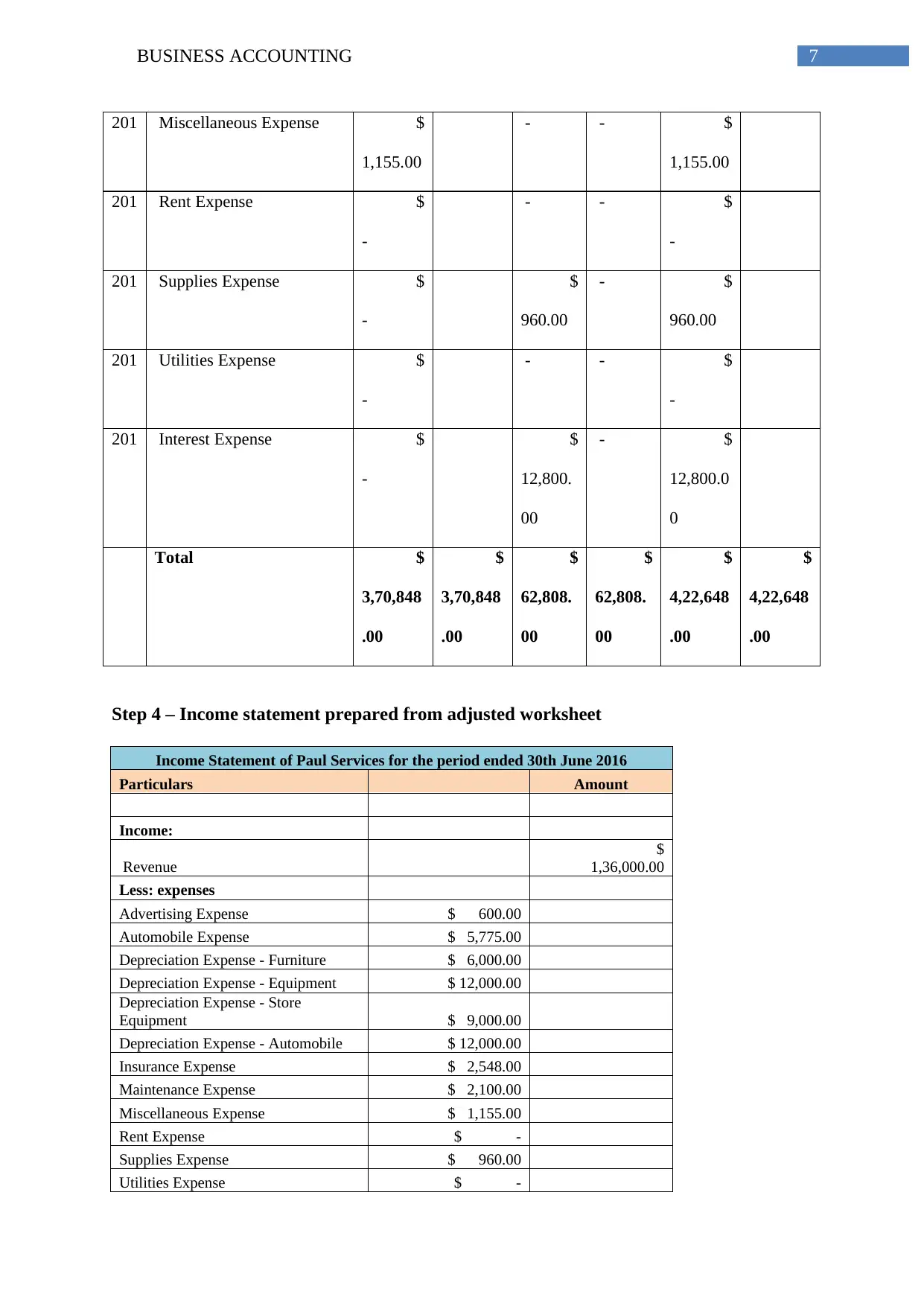
7BUSINESS ACCOUNTING
201 Miscellaneous Expense $
1,155.00
- - $
1,155.00
201 Rent Expense $
-
- - $
-
201 Supplies Expense $
-
$
960.00
- $
960.00
201 Utilities Expense $
-
- - $
-
201 Interest Expense $
-
$
12,800.
00
- $
12,800.0
0
Total $
3,70,848
.00
$
3,70,848
.00
$
62,808.
00
$
62,808.
00
$
4,22,648
.00
$
4,22,648
.00
Step 4 – Income statement prepared from adjusted worksheet
Income Statement of Paul Services for the period ended 30th June 2016
Particulars Amount
Income:
Revenue
$
1,36,000.00
Less: expenses
Advertising Expense $ 600.00
Automobile Expense $ 5,775.00
Depreciation Expense - Furniture $ 6,000.00
Depreciation Expense - Equipment $ 12,000.00
Depreciation Expense - Store
Equipment $ 9,000.00
Depreciation Expense - Automobile $ 12,000.00
Insurance Expense $ 2,548.00
Maintenance Expense $ 2,100.00
Miscellaneous Expense $ 1,155.00
Rent Expense $ -
Supplies Expense $ 960.00
Utilities Expense $ -
201 Miscellaneous Expense $
1,155.00
- - $
1,155.00
201 Rent Expense $
-
- - $
-
201 Supplies Expense $
-
$
960.00
- $
960.00
201 Utilities Expense $
-
- - $
-
201 Interest Expense $
-
$
12,800.
00
- $
12,800.0
0
Total $
3,70,848
.00
$
3,70,848
.00
$
62,808.
00
$
62,808.
00
$
4,22,648
.00
$
4,22,648
.00
Step 4 – Income statement prepared from adjusted worksheet
Income Statement of Paul Services for the period ended 30th June 2016
Particulars Amount
Income:
Revenue
$
1,36,000.00
Less: expenses
Advertising Expense $ 600.00
Automobile Expense $ 5,775.00
Depreciation Expense - Furniture $ 6,000.00
Depreciation Expense - Equipment $ 12,000.00
Depreciation Expense - Store
Equipment $ 9,000.00
Depreciation Expense - Automobile $ 12,000.00
Insurance Expense $ 2,548.00
Maintenance Expense $ 2,100.00
Miscellaneous Expense $ 1,155.00
Rent Expense $ -
Supplies Expense $ 960.00
Utilities Expense $ -
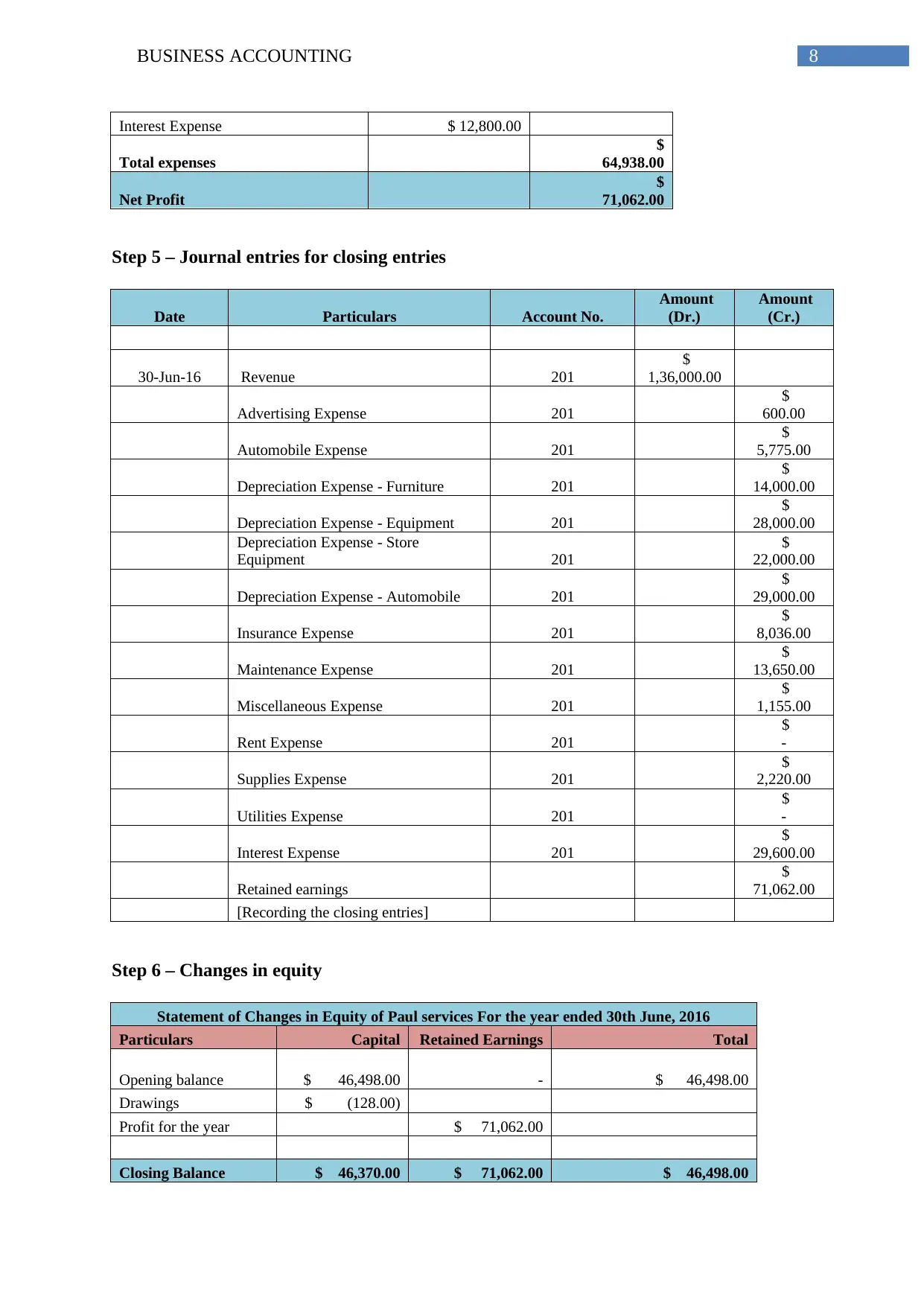
8BUSINESS ACCOUNTING
Interest Expense $ 12,800.00
Total expenses
$
64,938.00
Net Profit
$
71,062.00
Step 5 – Journal entries for closing entries
Date Particulars Account No.
Amount
(Dr.)
Amount
(Cr.)
30-Jun-16 Revenue 201
$
1,36,000.00
Advertising Expense 201
$
600.00
Automobile Expense 201
$
5,775.00
Depreciation Expense - Furniture 201
$
14,000.00
Depreciation Expense - Equipment 201
$
28,000.00
Depreciation Expense - Store
Equipment 201
$
22,000.00
Depreciation Expense - Automobile 201
$
29,000.00
Insurance Expense 201
$
8,036.00
Maintenance Expense 201
$
13,650.00
Miscellaneous Expense 201
$
1,155.00
Rent Expense 201
$
-
Supplies Expense 201
$
2,220.00
Utilities Expense 201
$
-
Interest Expense 201
$
29,600.00
Retained earnings
$
71,062.00
[Recording the closing entries]
Step 6 – Changes in equity
Statement of Changes in Equity of Paul services For the year ended 30th June, 2016
Particulars Capital Retained Earnings Total
Opening balance $ 46,498.00 - $ 46,498.00
Drawings $ (128.00)
Profit for the year $ 71,062.00
Closing Balance $ 46,370.00 $ 71,062.00 $ 46,498.00
Interest Expense $ 12,800.00
Total expenses
$
64,938.00
Net Profit
$
71,062.00
Step 5 – Journal entries for closing entries
Date Particulars Account No.
Amount
(Dr.)
Amount
(Cr.)
30-Jun-16 Revenue 201
$
1,36,000.00
Advertising Expense 201
$
600.00
Automobile Expense 201
$
5,775.00
Depreciation Expense - Furniture 201
$
14,000.00
Depreciation Expense - Equipment 201
$
28,000.00
Depreciation Expense - Store
Equipment 201
$
22,000.00
Depreciation Expense - Automobile 201
$
29,000.00
Insurance Expense 201
$
8,036.00
Maintenance Expense 201
$
13,650.00
Miscellaneous Expense 201
$
1,155.00
Rent Expense 201
$
-
Supplies Expense 201
$
2,220.00
Utilities Expense 201
$
-
Interest Expense 201
$
29,600.00
Retained earnings
$
71,062.00
[Recording the closing entries]
Step 6 – Changes in equity
Statement of Changes in Equity of Paul services For the year ended 30th June, 2016
Particulars Capital Retained Earnings Total
Opening balance $ 46,498.00 - $ 46,498.00
Drawings $ (128.00)
Profit for the year $ 71,062.00
Closing Balance $ 46,370.00 $ 71,062.00 $ 46,498.00
⊘ This is a preview!⊘
Do you want full access?
Subscribe today to unlock all pages.

Trusted by 1+ million students worldwide
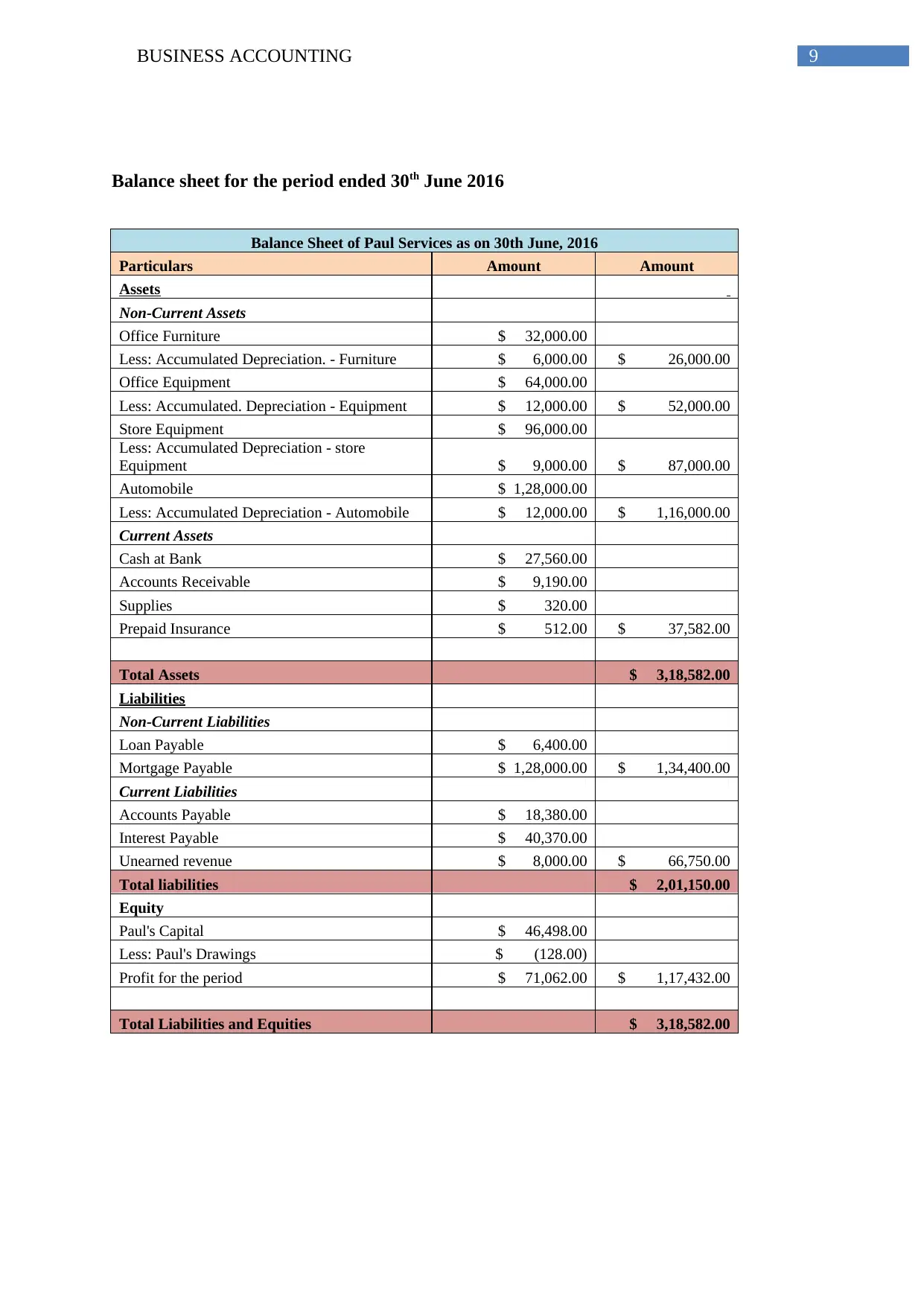
9BUSINESS ACCOUNTING
Balance sheet for the period ended 30th June 2016
Balance Sheet of Paul Services as on 30th June, 2016
Particulars Amount Amount
Assets
Non-Current Assets
Office Furniture $ 32,000.00
Less: Accumulated Depreciation. - Furniture $ 6,000.00 $ 26,000.00
Office Equipment $ 64,000.00
Less: Accumulated. Depreciation - Equipment $ 12,000.00 $ 52,000.00
Store Equipment $ 96,000.00
Less: Accumulated Depreciation - store
Equipment $ 9,000.00 $ 87,000.00
Automobile $ 1,28,000.00
Less: Accumulated Depreciation - Automobile $ 12,000.00 $ 1,16,000.00
Current Assets
Cash at Bank $ 27,560.00
Accounts Receivable $ 9,190.00
Supplies $ 320.00
Prepaid Insurance $ 512.00 $ 37,582.00
Total Assets $ 3,18,582.00
Liabilities
Non-Current Liabilities
Loan Payable $ 6,400.00
Mortgage Payable $ 1,28,000.00 $ 1,34,400.00
Current Liabilities
Accounts Payable $ 18,380.00
Interest Payable $ 40,370.00
Unearned revenue $ 8,000.00 $ 66,750.00
Total liabilities $ 2,01,150.00
Equity
Paul's Capital $ 46,498.00
Less: Paul's Drawings $ (128.00)
Profit for the period $ 71,062.00 $ 1,17,432.00
Total Liabilities and Equities $ 3,18,582.00
Balance sheet for the period ended 30th June 2016
Balance Sheet of Paul Services as on 30th June, 2016
Particulars Amount Amount
Assets
Non-Current Assets
Office Furniture $ 32,000.00
Less: Accumulated Depreciation. - Furniture $ 6,000.00 $ 26,000.00
Office Equipment $ 64,000.00
Less: Accumulated. Depreciation - Equipment $ 12,000.00 $ 52,000.00
Store Equipment $ 96,000.00
Less: Accumulated Depreciation - store
Equipment $ 9,000.00 $ 87,000.00
Automobile $ 1,28,000.00
Less: Accumulated Depreciation - Automobile $ 12,000.00 $ 1,16,000.00
Current Assets
Cash at Bank $ 27,560.00
Accounts Receivable $ 9,190.00
Supplies $ 320.00
Prepaid Insurance $ 512.00 $ 37,582.00
Total Assets $ 3,18,582.00
Liabilities
Non-Current Liabilities
Loan Payable $ 6,400.00
Mortgage Payable $ 1,28,000.00 $ 1,34,400.00
Current Liabilities
Accounts Payable $ 18,380.00
Interest Payable $ 40,370.00
Unearned revenue $ 8,000.00 $ 66,750.00
Total liabilities $ 2,01,150.00
Equity
Paul's Capital $ 46,498.00
Less: Paul's Drawings $ (128.00)
Profit for the period $ 71,062.00 $ 1,17,432.00
Total Liabilities and Equities $ 3,18,582.00
Paraphrase This Document
Need a fresh take? Get an instant paraphrase of this document with our AI Paraphraser
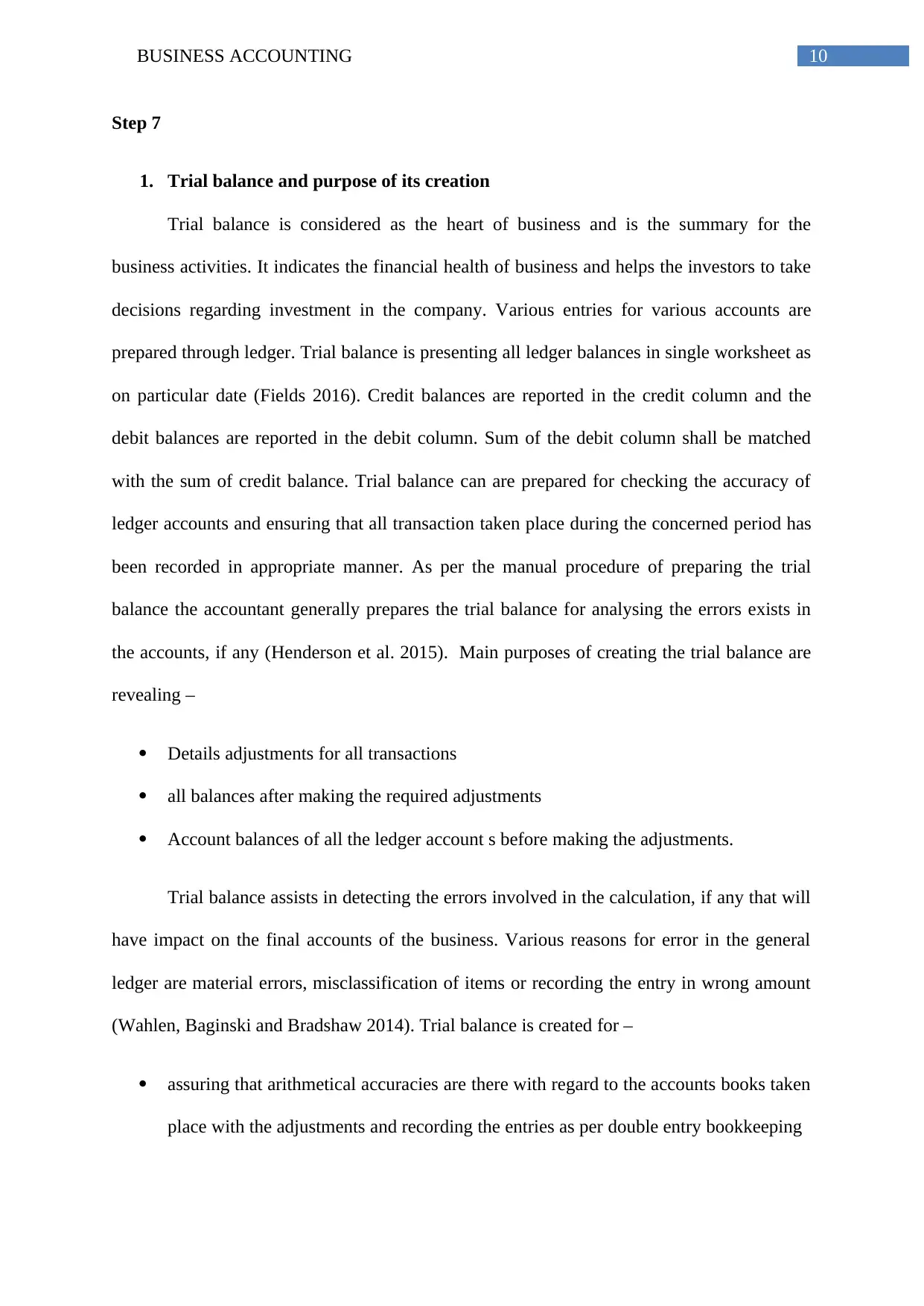
10BUSINESS ACCOUNTING
Step 7
1. Trial balance and purpose of its creation
Trial balance is considered as the heart of business and is the summary for the
business activities. It indicates the financial health of business and helps the investors to take
decisions regarding investment in the company. Various entries for various accounts are
prepared through ledger. Trial balance is presenting all ledger balances in single worksheet as
on particular date (Fields 2016). Credit balances are reported in the credit column and the
debit balances are reported in the debit column. Sum of the debit column shall be matched
with the sum of credit balance. Trial balance can are prepared for checking the accuracy of
ledger accounts and ensuring that all transaction taken place during the concerned period has
been recorded in appropriate manner. As per the manual procedure of preparing the trial
balance the accountant generally prepares the trial balance for analysing the errors exists in
the accounts, if any (Henderson et al. 2015). Main purposes of creating the trial balance are
revealing –
Details adjustments for all transactions
all balances after making the required adjustments
Account balances of all the ledger account s before making the adjustments.
Trial balance assists in detecting the errors involved in the calculation, if any that will
have impact on the final accounts of the business. Various reasons for error in the general
ledger are material errors, misclassification of items or recording the entry in wrong amount
(Wahlen, Baginski and Bradshaw 2014). Trial balance is created for –
assuring that arithmetical accuracies are there with regard to the accounts books taken
place with the adjustments and recording the entries as per double entry bookkeeping
Step 7
1. Trial balance and purpose of its creation
Trial balance is considered as the heart of business and is the summary for the
business activities. It indicates the financial health of business and helps the investors to take
decisions regarding investment in the company. Various entries for various accounts are
prepared through ledger. Trial balance is presenting all ledger balances in single worksheet as
on particular date (Fields 2016). Credit balances are reported in the credit column and the
debit balances are reported in the debit column. Sum of the debit column shall be matched
with the sum of credit balance. Trial balance can are prepared for checking the accuracy of
ledger accounts and ensuring that all transaction taken place during the concerned period has
been recorded in appropriate manner. As per the manual procedure of preparing the trial
balance the accountant generally prepares the trial balance for analysing the errors exists in
the accounts, if any (Henderson et al. 2015). Main purposes of creating the trial balance are
revealing –
Details adjustments for all transactions
all balances after making the required adjustments
Account balances of all the ledger account s before making the adjustments.
Trial balance assists in detecting the errors involved in the calculation, if any that will
have impact on the final accounts of the business. Various reasons for error in the general
ledger are material errors, misclassification of items or recording the entry in wrong amount
(Wahlen, Baginski and Bradshaw 2014). Trial balance is created for –
assuring that arithmetical accuracies are there with regard to the accounts books taken
place with the adjustments and recording the entries as per double entry bookkeeping
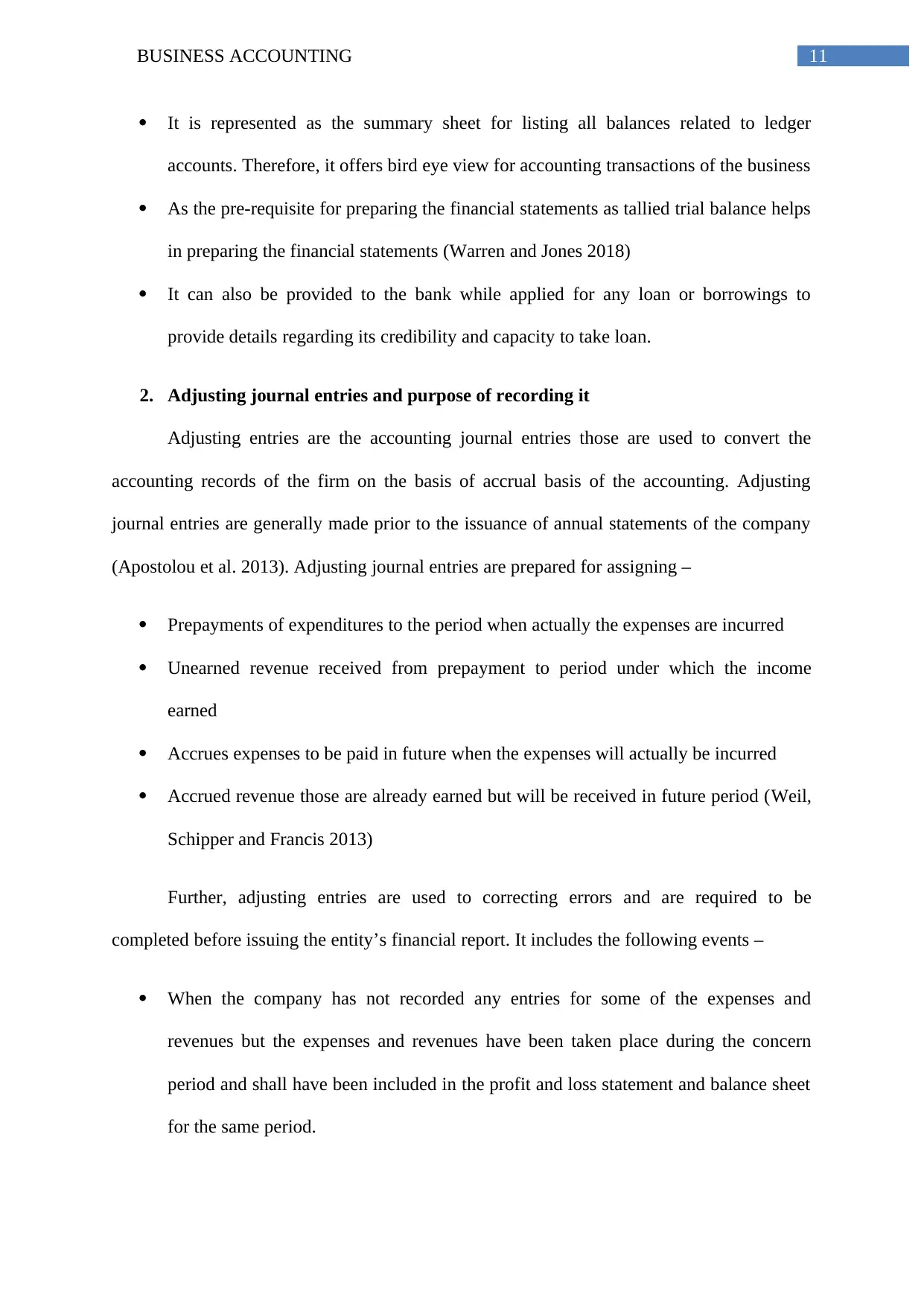
11BUSINESS ACCOUNTING
It is represented as the summary sheet for listing all balances related to ledger
accounts. Therefore, it offers bird eye view for accounting transactions of the business
As the pre-requisite for preparing the financial statements as tallied trial balance helps
in preparing the financial statements (Warren and Jones 2018)
It can also be provided to the bank while applied for any loan or borrowings to
provide details regarding its credibility and capacity to take loan.
2. Adjusting journal entries and purpose of recording it
Adjusting entries are the accounting journal entries those are used to convert the
accounting records of the firm on the basis of accrual basis of the accounting. Adjusting
journal entries are generally made prior to the issuance of annual statements of the company
(Apostolou et al. 2013). Adjusting journal entries are prepared for assigning –
Prepayments of expenditures to the period when actually the expenses are incurred
Unearned revenue received from prepayment to period under which the income
earned
Accrues expenses to be paid in future when the expenses will actually be incurred
Accrued revenue those are already earned but will be received in future period (Weil,
Schipper and Francis 2013)
Further, adjusting entries are used to correcting errors and are required to be
completed before issuing the entity’s financial report. It includes the following events –
When the company has not recorded any entries for some of the expenses and
revenues but the expenses and revenues have been taken place during the concern
period and shall have been included in the profit and loss statement and balance sheet
for the same period.
It is represented as the summary sheet for listing all balances related to ledger
accounts. Therefore, it offers bird eye view for accounting transactions of the business
As the pre-requisite for preparing the financial statements as tallied trial balance helps
in preparing the financial statements (Warren and Jones 2018)
It can also be provided to the bank while applied for any loan or borrowings to
provide details regarding its credibility and capacity to take loan.
2. Adjusting journal entries and purpose of recording it
Adjusting entries are the accounting journal entries those are used to convert the
accounting records of the firm on the basis of accrual basis of the accounting. Adjusting
journal entries are generally made prior to the issuance of annual statements of the company
(Apostolou et al. 2013). Adjusting journal entries are prepared for assigning –
Prepayments of expenditures to the period when actually the expenses are incurred
Unearned revenue received from prepayment to period under which the income
earned
Accrues expenses to be paid in future when the expenses will actually be incurred
Accrued revenue those are already earned but will be received in future period (Weil,
Schipper and Francis 2013)
Further, adjusting entries are used to correcting errors and are required to be
completed before issuing the entity’s financial report. It includes the following events –
When the company has not recorded any entries for some of the expenses and
revenues but the expenses and revenues have been taken place during the concern
period and shall have been included in the profit and loss statement and balance sheet
for the same period.
⊘ This is a preview!⊘
Do you want full access?
Subscribe today to unlock all pages.

Trusted by 1+ million students worldwide
1 out of 17
Related Documents
Your All-in-One AI-Powered Toolkit for Academic Success.
+13062052269
info@desklib.com
Available 24*7 on WhatsApp / Email
![[object Object]](/_next/static/media/star-bottom.7253800d.svg)
Unlock your academic potential
Copyright © 2020–2025 A2Z Services. All Rights Reserved. Developed and managed by ZUCOL.





